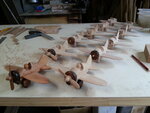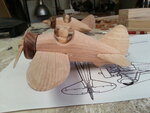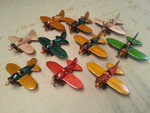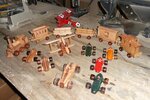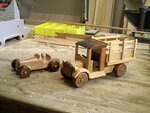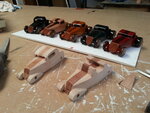- Thread starter
- #21
Navigation
Install the app
How to install the app on iOS
Follow along with the video below to see how to install our site as a web app on your home screen.
Note: This feature may not be available in some browsers.
More options
You are using an out of date browser. It may not display this or other websites correctly.
You should upgrade or use an alternative browser.
You should upgrade or use an alternative browser.
Hawker Hurricane or Brewster Buffalo
- Thread starter ssnider
- Start date
Ad: This forum contains affiliate links to products on Amazon and eBay. More information in Terms and rules
More options
Who Replied?wingnuts
Airman 1st Class
I rate the Buffalo as the worst fighter produced by the U.S.A. to be used in the war with the sole exception of the Boeing P-26 Peashooter that was pretty good when it entered service but was obsolete when WWII broke out. The success of the Buffalo in Finland can be attributed to a few points including:
1) Very poor Soviet opposition with green pilots in obsolete types, fighting over enemy territory. Anyone who went down and lived was probably lost or captured.
2) Experienced and talented Finnish pilots, fighting FOR their country over their own territory. Anyone who went down and lived was repatriated and could return to duty.
Also, the Buffalo as it served in US service didn't climb at over 3,000 feet per minute. It was more like 2,400 fpm. From all reports, it was a pleasant aircraft to fly, but not really in the fighter league. Aerobatics were "gentlemanly," not spirited. The armament was not very good, but was sufficient against lightly-built or obsolete opponents that had ever worse fighter performance than the Buffalo.
It did NOT have a 26 : 1 kill ratio as a type, only in Finnish service. When you state a kill ratio, it must include the population of the type. Otherwise, where do you stop? With one mission? I can point out missions where almost all WWII fighter types had a combat kill without loss. That doesn't mean the type had an outstanding kill ratio.
Imagine if the Finns had GOOD fighters in service!
Despite the Boeing P-26 Peashooter being obsolete Jesus Villamor and his PAAC squadron did manage to shoot down three A6M Zeros and a G3M bomber, The Philippine Air Force Base next to Manila Airport (NAIA) is named after him. Before the war he taught General Eisenhower to fly.
GregP
Major
I like the P-26 Peashooter. Our museum flies one. I may have been obsolescent when WWII broke out, but it was cutting edge in 1932 when it was new. Neat little airplane unless YOU are the guy who has to turn the crank to start the engine. Actually, I like the Buffalo, too. It just wasn't able to live in a sky filled with competent pilots flying WWII fighters that were all better-performing than the Buffalo.
That doesn't mean the Buffalo was a flop. It means it didn't get adopted and developed into a better fighter. If I recall correctly, it won against the Wildcat in competition, but the Wildcat got adopted and developed. I think the Buffalo could have been just as good if not better, had it received the attention the Wildcat did.
But alternate histories did not happen and the Buffalo didn't get deployed by the US Navy in large numbers, so it's record it what it was ... not terribly good. I don't hate the Buffalo at all. It just wasn't what other, better WWII fighters were.
That doesn't mean the Buffalo was a flop. It means it didn't get adopted and developed into a better fighter. If I recall correctly, it won against the Wildcat in competition, but the Wildcat got adopted and developed. I think the Buffalo could have been just as good if not better, had it received the attention the Wildcat did.
But alternate histories did not happen and the Buffalo didn't get deployed by the US Navy in large numbers, so it's record it what it was ... not terribly good. I don't hate the Buffalo at all. It just wasn't what other, better WWII fighters were.
Shortround6
Lieutenant General
Sometimes certain aircraft are trapped to some extent by the initial design and it is too hard to modify the plane to break out of the path of development that it is on.
The Buffalo used integral fuel tanks. So did several other US planes at the time, The P-43 (I don't know about P-35) the Vought Kingfisher and the prototype and early Corsairs. Catalina flying boat also used integral tanks. Maybe some others?
It promised a lightweight way to store the fuel leading to a lower weight/higher performing airplane. Unfortunately for the Buffalo figuring out alternative fuel storage once self sealing was desired (several years after design started) was harder than some other planes. The Corsair, after the prototype, moved the cockpit back about 3 feet and fitted a protected tank inside the long nose. The unprotected wing tanks became auxiliary tanks and finally deleted. The PBY Catalina fuel spaces were large enough that self sealing fuel cells could be dropped into the old fuel spaces (although capacity was greatly diminished). They tried to seal the P-43 tanks but they leaked even without combat damage.
That was not the only problem. While the Wright cyclone and the P & W Twin Wasp were often interchangeable that might not have been true in all cases (my opinion) and the Brewster Buffalo may have been one of those cases. The F2A-1 (and the 239) were about 8 in longer than the later planes. They used a lighter/lower powered version of the Cyclone and the shorter front fuselage on the later versions may have been an attempt to maintain the center of gravity with the later/heavier model Cyclones. Trying to stuff the even heavier (and longer) Twin Wasp into the Buffalo might have presented more problems than swapping the engines back and forth in the F4F/Martlet and the P-36/Hawk 75?
The Hawk75/P-36 having been designed for a two row radial in the first place (although one that did not reach production).
The Buffalo may have been designed a bit too tight (low weight) to begin with and didn't handle the increases in weight as well as the larger F4F(F4Fs wing was about 25% bigger in area) ?

Trying to stuff a Twin Wasp that is 100-200lbs heavier under that cowl (and being a longer engine) may not have been easy leaving it stuck with the Cyclone engine which was not getting rave reviews as a fighter engine at the time. Also please note the fairing on the wing covering the rear of the .50 cal Browning in the wing.
Maybe the Buffalo could have been modified, it just might have been a lot more work and with the lack of speed that Brewster seemed to show it might have been a situation of too little too late.
The Buffalo used integral fuel tanks. So did several other US planes at the time, The P-43 (I don't know about P-35) the Vought Kingfisher and the prototype and early Corsairs. Catalina flying boat also used integral tanks. Maybe some others?
It promised a lightweight way to store the fuel leading to a lower weight/higher performing airplane. Unfortunately for the Buffalo figuring out alternative fuel storage once self sealing was desired (several years after design started) was harder than some other planes. The Corsair, after the prototype, moved the cockpit back about 3 feet and fitted a protected tank inside the long nose. The unprotected wing tanks became auxiliary tanks and finally deleted. The PBY Catalina fuel spaces were large enough that self sealing fuel cells could be dropped into the old fuel spaces (although capacity was greatly diminished). They tried to seal the P-43 tanks but they leaked even without combat damage.
That was not the only problem. While the Wright cyclone and the P & W Twin Wasp were often interchangeable that might not have been true in all cases (my opinion) and the Brewster Buffalo may have been one of those cases. The F2A-1 (and the 239) were about 8 in longer than the later planes. They used a lighter/lower powered version of the Cyclone and the shorter front fuselage on the later versions may have been an attempt to maintain the center of gravity with the later/heavier model Cyclones. Trying to stuff the even heavier (and longer) Twin Wasp into the Buffalo might have presented more problems than swapping the engines back and forth in the F4F/Martlet and the P-36/Hawk 75?
The Hawk75/P-36 having been designed for a two row radial in the first place (although one that did not reach production).
The Buffalo may have been designed a bit too tight (low weight) to begin with and didn't handle the increases in weight as well as the larger F4F(F4Fs wing was about 25% bigger in area) ?
Trying to stuff a Twin Wasp that is 100-200lbs heavier under that cowl (and being a longer engine) may not have been easy leaving it stuck with the Cyclone engine which was not getting rave reviews as a fighter engine at the time. Also please note the fairing on the wing covering the rear of the .50 cal Browning in the wing.
Maybe the Buffalo could have been modified, it just might have been a lot more work and with the lack of speed that Brewster seemed to show it might have been a situation of too little too late.
wingnuts
Airman 1st Class
I like the P-26 Peashooter. Our museum flies one. I may have been obsolescent when WWII broke out, but it was cutting edge in 1932 when it was new. Neat little airplane unless YOU are the guy who has to turn the crank to start the engine. Actually, I like the Buffalo, too. It just wasn't able to live in a sky filled with competent pilots flying WWII fighters that were all better-performing than the Buffalo.
That doesn't mean the Buffalo was a flop. It means it didn't get adopted and developed into a better fighter. If I recall correctly, it won against the Wildcat in competition, but the Wildcat got adopted and developed. I think the Buffalo could have been just as good if not better, had it received the attention the Wildcat did.
But alternate histories did not happen and the Buffalo didn't get deployed by the US Navy in large numbers, so it's record it what it was ... not terribly good. I don't hate the Buffalo at all. It just wasn't what other, better WWII fighters were.
I used to make wooden toys in my spare time a few years ago, I liked it so much I used the basic Peashooter as one of my designs.
Attachments
Hi,
I think one of the issues with trying to modify the Buffalo is just that its design fell into a period where rapid changes were occurring and larger airframes were warranted to take advantage of those changes. Specifically, if I am understanding correctly, I believe that the F6F Hellcat initially evolved out of studies trying to see if the F4F could be adapted to accommodate the R2800 engine, but that it was rapidly realized that a whole new aircraft design was warranted.
Additionally, as I understand it, the FM-2 version of the F4F design was kept in production because it was primarily able to fill a niche on ASW escort carriers, with its small size and folding wings making for a reasonable small but fast enough package that could complement the larger and slower TBF/TBMs in countering surfaced submarines and suppressing their AA abilities.
Pat
PS. Wingnut, I like your wooden toys
I think one of the issues with trying to modify the Buffalo is just that its design fell into a period where rapid changes were occurring and larger airframes were warranted to take advantage of those changes. Specifically, if I am understanding correctly, I believe that the F6F Hellcat initially evolved out of studies trying to see if the F4F could be adapted to accommodate the R2800 engine, but that it was rapidly realized that a whole new aircraft design was warranted.
Additionally, as I understand it, the FM-2 version of the F4F design was kept in production because it was primarily able to fill a niche on ASW escort carriers, with its small size and folding wings making for a reasonable small but fast enough package that could complement the larger and slower TBF/TBMs in countering surfaced submarines and suppressing their AA abilities.
Pat
PS. Wingnut, I like your wooden toys
I used to make wooden toys in my spare time a few years ago, I liked it so much I used the basic Peashooter as one of my designs.
Nice factory assembly line you've got there!
- Thread starter
- #28
ThomasP
Chief Master Sergeant
Interesting info on the landing gear failure mode. I had never run across any explanation before except that the landing gear was "weak" or poorly designed. Thanks for the details.
Clayton Magnet
Staff Sergeant
- 912
- Feb 16, 2013
The F6F Originally had the R2600 fitted, but was quickly redesigned for the R2800I believe that the F6F Hellcat initially evolved out of studies trying to see if the F4F could be adapted to accommodate the R2800 engine, but that it was rapidly realized that a whole new aircraft design was warranted.
The F6F Originally had the R2600 fitted, but was quickly redesigned for the R2800
Yup, the Hellcat evolved through many paper incarnations into what it was following Grumman's paper project F4F powered by an R2600. The final iteration of what became the F6F was drawn up and dated January 6 1941. Remarkably (like everything with the Hellcat), it took a month from the prototype F6F-1's first flight on June 26 1942 powered by the 2600, before it flew with the 2800 for the first time on July 30.
wingnuts
Airman 1st Class
Hi,
I think one of the issues with trying to modify the Buffalo is just that its design fell into a period where rapid changes were occurring and larger airframes were warranted to take advantage of those changes. Specifically, if I am understanding correctly, I believe that the F6F Hellcat initially evolved out of studies trying to see if the F4F could be adapted to accommodate the R2800 engine, but that it was rapidly realized that a whole new aircraft design was warranted.
Additionally, as I understand it, the FM-2 version of the F4F design was kept in production because it was primarily able to fill a niche on ASW escort carriers, with its small size and folding wings making for a reasonable small but fast enough package that could complement the larger and slower TBF/TBMs in countering surfaced submarines and suppressing their AA abilities.
Pat
PS. Wingnut, I like your wooden toys
Thanks, I wish I still had time to do more.
Attachments
Finns also had a few Hurricanes, but there is not much to tell about them. Although the plane was fast compared to other Finnish planes and even though it had firepower, it was considered a clumsy and rigid plane and was not liked. Note that most of the air battles here were low, below 5000m, even below 3000m.
Admiral Beez
Major
The R2800 has to be one of the best, if not the best radial aircraft engine designed before the war.The F6F Originally had the R2600 fitted, but was quickly redesigned for the R2800
Clayton Magnet
Staff Sergeant
- 912
- Feb 16, 2013
Drifting off topic here, but, was it ACTUALLY the best? or just the most prolific and developed?The R2800 has to be one of the best, if not the best radial aircraft engine designed before the war.
Admiral Beez
Major
Not necessary an indication of being the best, but It's still used today in commercial and government service, 82 years after its first run. For example, the Canadair CL-215 uses it today in the non-turbo prop variants.Drifting off topic here, but, was it ACTUALLY the best? or just the most prolific and developed?
Clayton Magnet
Staff Sergeant
- 912
- Feb 16, 2013
that's kinda my point. I am sure the R2800 is/was a fine engine, but it continues in service today because American manufacturers tended to prefer air cooled engines, and American aircraft were the norm in the postwar era.
One of the reasons the Buffalo did well with the Finn's.
They solved the Cyclone engine from spewing oil all over the Windscreen operating at full throttle.
This was a key complaint with the Brits in China and with the Dutch in Indonesia.
Finn's actually had three advantages.
Cold / Cool weather helped performance especially at full throttle.
Less Dust which did not wear out the engines
Finn's reversed the last oil ring pushing oil back into the case.
From Panu Kolju:
The oil circulation with one or two of the pistons in the Finnish Brewster fighters was a problem which shortened the life of the engine and rised the temperature in the engine, which you also mentioned in your story. I recall that one of the piston oil rings was turned upside down to "push the oil" to the piston chamber, which in turn lowered the temperature and provided better oil surface for the piston. This job was done to all Brewster engines as soon as the problem was discovered. I was surprised that it was also problem with other Brewster types, like you said in your story, and wonder if this is the problem behind all those heat problems you described in the article.
They solved the Cyclone engine from spewing oil all over the Windscreen operating at full throttle.
This was a key complaint with the Brits in China and with the Dutch in Indonesia.
Finn's actually had three advantages.
Cold / Cool weather helped performance especially at full throttle.
Less Dust which did not wear out the engines
Finn's reversed the last oil ring pushing oil back into the case.
From Panu Kolju:
The oil circulation with one or two of the pistons in the Finnish Brewster fighters was a problem which shortened the life of the engine and rised the temperature in the engine, which you also mentioned in your story. I recall that one of the piston oil rings was turned upside down to "push the oil" to the piston chamber, which in turn lowered the temperature and provided better oil surface for the piston. This job was done to all Brewster engines as soon as the problem was discovered. I was surprised that it was also problem with other Brewster types, like you said in your story, and wonder if this is the problem behind all those heat problems you described in the article.
Thanks, I wish I still had time to do more.
Hi,
Those look really nice. I like the way you make use of the different wood tone/types.
Users who are viewing this thread
Total: 1 (members: 0, guests: 1)

